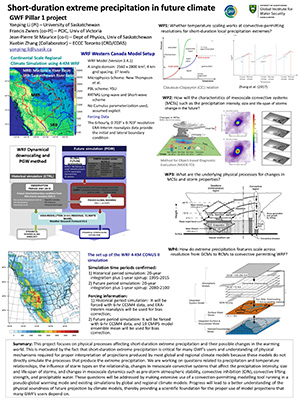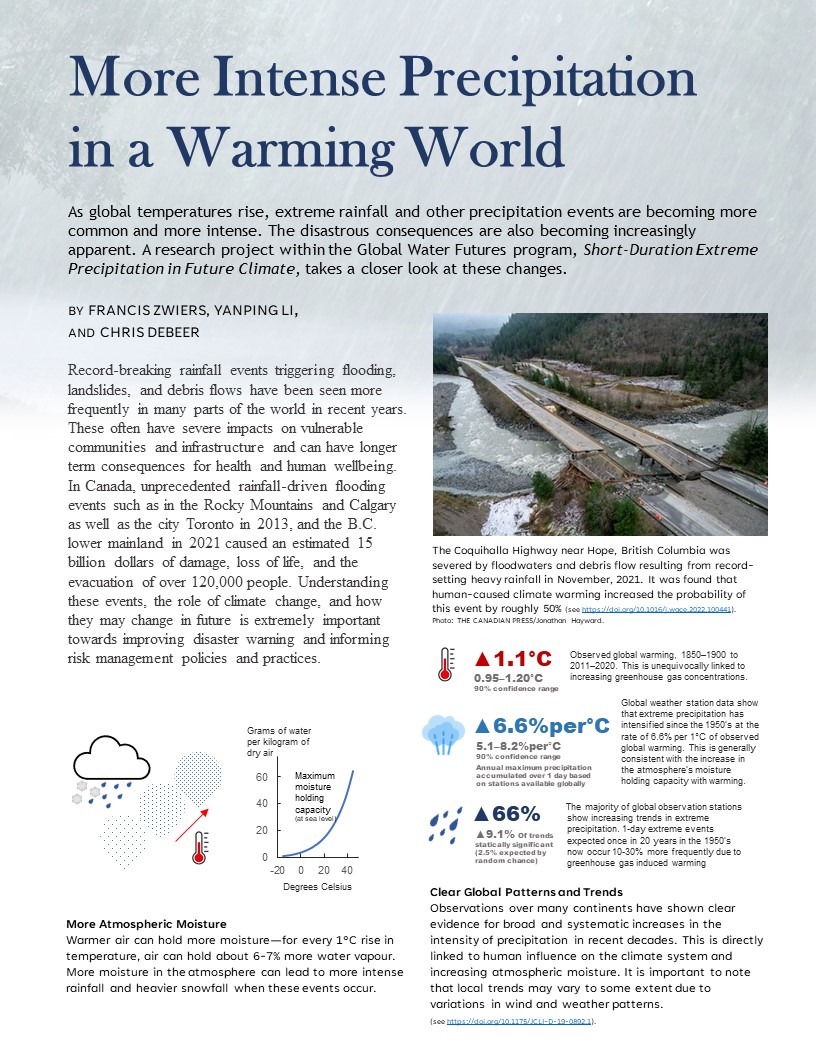Short‐Duration Extreme Precipitation in Future Climate
This project focuses on physical processes affecting short-duration extreme precipitation and their
possible changes in the warming world.
Understanding of the physical processes affecting short‐duration (less than 24 hours) extreme precipitation and their possible changes in the warming world is critical for many of GWF’s users. However, most global and regional climate models do not directly simulate the processes that produce localized extreme precipitation due to their coarse resolutions, which hinders the proper interpretation of the precipitation projections produced by these models. Such questions can be addressed by making extensive use of a convection‐permitting modeling tool running in a pseudo‐global warming mode, and comparing it with existing simulations by global and regional climate models. This project specifically addresses the following four questions: i) Does temperature scaling work at convective‐permitting resolutions for short‐duration local precipitation extremes? ii) How will the characteristics of mesoscale convective systems (MCSs) such as the precipitation intensity, size, and life‐span of storms change in the future? iii) What are the underlying physical processes that result in changes in MCSs and storm properties? iv) How do extreme precipitation features scale across resolution from global climate models (GCMs) to regional climate models (RCMs) to convective permitting Weather Research and Forecasting (WRF) model simulations? Our work will lead to a better understanding of the physical soundness of future precipitation projections by climate models, thereby providing a scientific foundation for the proper use of model projections that many GWF’s users depend on.

Click to view PDF
(To download, right-click and select "Save Link As")
Principal and Co-Investigators
- Yanping Li, University of Saskatchewan
- Francis Zwiers, Pacific Climate Impacts Consortium, University of Victoria
- Jean-Pierre St Maurice, University of Saskatchewan
- Xuebin Zhang, Environment and Climate Change Canada
Former and Current Post-Doctoral Fellows
- Qiaohong Sun, Pacific Climate Impacts Consortium, University of Victoria
- Zhenhua Li, University of Saskatchewan
- Lintao Li, University of Saskatchewan
- Chao Li, Pacific Climate Impacts Consortium, University of Victoria
- Xiaohui Zhao, University of Saskatchewan
- Zhe Zhang, University of Saskatchewan
Former and Current Students
- Lucia Scaff, University of Saskatchewan, PhD Thesis
- Mostofa Kamal, University of Saskatchewan
- Yunsung Hwang, University of Saskatchewan
- Jason Flemke, University of Sasaktchewan, MSc Thesis
International Collaborators and Visiting Fellows
- He Sun, Institute of Tibet Plateau Research, Chinese Academy of Science (CAS)
- Andreas Prein, US National Center for Atmospheric Research (NCAR)
- Ethan Gutmann, US National Center for Atmospheric Research (NCAR)
- Jason Evans, University of New South Wales
- Frank Robinson, Yale University
- Ya Huang, China Institute of Water Resources and Hydropower Research (IWHR)
2022 - 2023
- Gillett, N.P., Cannon, A.J., Malinina, E., Schnorbus, M., Anslow, F., Sun, Q., Kirchmeier-Young, M., Zwiers, F., Seiler, C., Zhang, X. and Flato, G., 2022. Human influence on the 2021 British Columbia floods. Weather and Climate Extremes, 36, p.100441. https://doi.org/10.1016/j.wace.2022.100441
- Tan, Y., Yang, S., Zwiers, F., Wang, Z. and Sun, Q., 2022. Moisture budget analysis of extreme precipitation associated with different types of atmospheric rivers over western North America. Climate Dynamics, 58(3-4), pp.793-809. https://doi.org/10.1007/s00382-021-05933-3
- Sun, Q., Zwiers, F., Zhang, X. and Yan, J., 2022. Quantifying the human influence on the intensity of extreme 1-and 5-day precipitation amounts at global, continental, and regional scales. Journal of Climate, 35(1), pp.195-210. https://doi.org/10.1175/JCLI-D-21-0028.1
2020 - 2021
- Ben Alaya, M.A., Zwiers, F.W. and Zhang, X., 2020. A bivariate approach to estimating the probability of very extreme precipitation events. Weather and Climate Extremes, 30, p.100290. https://doi.org/10.1016/j.wace.2020.100290
- Ben Alaya, M.A., Zwiers, F.W. and Zhang, X., 2020. Probable maximum precipitation in a warming climate over North America in CanRCM4 and CRCM5. Climatic Change, 158, pp.611-629. https://doi.org/10.1007/s10584-019-02591-7
- Ben Alaya, M., Zwiers, F. and Zhang, X., 2020. An evaluation of block-maximum-based estimation of very long return period precipitation extremes with a large ensemble climate simulation. Journal of Climate, 33(16), pp.6957-6970. https://doi.org/10.1175/JCLI-D-19-0011.1
- Huang, W.K., Monahan, A.H. and Zwiers, F.W., 2021. Estimating concurrent climate extremes: A conditional approach. Weather and Climate Extremes, 33, p.100332. https://doi.org/10.1016/j.wace.2021.100332
- Kurkute, S., Li, Z., Li, Y. and Huo, F., 2020. Assessment and projection of the water budget over western Canada using convection-permitting weather research and forecasting simulations. Hydrology and Earth System Sciences, 24(7), pp.3677-3697. https://doi.org/10.5194/hess-24-3677-2020
- Li, C., Zwiers, F., Zhang, X., Li, G., Sun, Y. and Wehner, M., 2021. Changes in annual extremes of daily temperature and precipitation in CMIP6 models. Journal of Climate, 34(9), pp.3441-3460. https://doi.org/10.1175/JCLI-D-19-1013.1
- Li, L., Li, Y. and Li, Z., 2020. Object-based tracking of precipitation systems in western Canada: the importance of temporal resolution of source data. Climate Dynamics, 55(9-10), pp.2421-2437. https://doi.org/10.1007/s00382-020-05388-y
- Li, Z., Li, Y., Yang, D. and Shrestha, R.R., 2021. Regional Climate Modeling in the Northern Regions. In: Yang, D., Kane, D.L. (eds) Arctic Hydrology, Permafrost and Ecosystems. Springer, Cham., pp.795-814. https://doi.org/10.1007/978-3-030-50930-9_27
- Li, Y., Li, Z., 2021. High-Resolution Weather Research Forecasting (WRF) Modeling and Projection Over Western Canada, Including Mackenzie Watershed. In: Yang, D., Kane, D.L. (eds) Arctic Hydrology, Permafrost and Ecosystems. Springer, Cham. https://doi.org/10.1007/978-3-030-50930-9_28
- Paik, S., Min, S.K., Zhang, X., Donat, M.G., King, A.D. and Sun, Q., 2020. Determining the anthropogenic greenhouse gas contribution to the observed intensification of extreme precipitation. Geophysical Research Letters, 47(12), p.e2019GL086875. https://doi.org/10.1029/2019GL086875
- Scaff, L., Prein, A.F., Li, Y., Liu, C., Rasmussen, R. and Ikeda, K., 2020. Simulating the convective precipitation diurnal cycle in North America’s current and future climate. Climate Dynamics, 55, pp.369-382. https://doi.org/10.1007/s00382-019-04754-9
- Sun, Q., Zwiers, F., Zhang, X. and Li, G., 2020. A comparison of intra-annual and long-term trend scaling of extreme precipitation with temperature in a large-ensemble regional climate simulation. Journal of Climate, 33(21), pp.9233-9245. https://doi.org/10.1175/JCLI-D-19-0920.1
- Sun, Q., Zhang, X., Zwiers, F., Westra, S. and Alexander, L.V., 2021. A global, continental, and regional analysis of changes in extreme precipitation. Journal of Climate, 34(1), pp.243-258. https://doi.org/10.1175/JCLI-D-19-0892.1
- Tan, Y., Zwiers, F., Yang, S., Li, C. and Deng, K., 2020. The role of circulation and its changes in present and future atmospheric rivers over western North America. Journal of Climate, 33(4), pp.1261-1281. https://doi.org/10.1175/JCLI-D-19-0134.1
- Zhang, Z., Li, Y., Chen, F., Barlage, M. and Li, Z., 2020. Evaluation of convection-permitting WRF CONUS simulation on the relationship between soil moisture and heatwaves. Climate Dynamics, 55, pp.235-252. https://doi.org/10.1007/s00382-018-4508-5
2018 - 2019
- Ben Alaya, M., Zwiers, F. and Zhang, X., 2019. Evaluation and comparison of CanRCM4 and CRCM5 to estimate probable maximum precipitation over North America. Journal of Hydrometeorology, 20(10), pp.2069-2089. https://doi.org/10.1175/JHM-D-18-0233.1
- Chen, L., Li, Y., Chen, F., Barlage, M., Zhang, Z. and Li, Z., 2019. Using 4-km WRF CONUS simulations to assess impacts of the surface coupling strength on regional climate simulation. Climate Dynamics, 53, pp.6397-6416. https://doi.org/10.1007/s00382-019-04932-9
- Li, C., Zwiers, F., Zhang, X. and Li, G., 2019. How much information is required to well constrain local estimates of future precipitation extremes?. Earth's Future, 7(1), pp.11-24. https://doi.org/10.1029/2018EF001001
- Li, C., Zwiers, F., Zhang, X., Chen, G., Lu, J., Li, G., Norris, J., Tan, Y., Sun, Y. and Liu, M., 2019. Larger increases in more extreme local precipitation events as climate warms. Geophysical Research Letters, 46(12), pp.6885-6891. https://doi.org/10.1029/2019GL082908
- Li, Y., Li, Z., Zhang, Z., Chen, L., Kurkute, S., Scaff, L. and Pan, X., 2019. High-resolution regional climate modeling and projection over western Canada using a weather research forecasting model with a pseudo-global warming approach. Hydrology and Earth System Sciences, 23(11), pp.4635-4659. https://doi.org/10.5194/hess-23-4635-2019
- Li, Z., Li, Y., Bonsal, B., Manson, A.H. and Scaff, L., 2018. Combined impacts of ENSO and MJO on the 2015 growing season drought on the Canadian Prairies. Hydrology and Earth System Sciences, 22(10), pp.5057-5067. https://doi.org/10.5194/hess-22-5057-2018

This project has made a number of important advances in understanding extreme short-duration precipitation.
- Examination of the frequently used “binning scaling” calculation of the relationship between temperature change and extreme precipitation change (https://doi.org/10.1175/JCLI-D-19-0920.1), observed trends in extreme precip (https://doi.org/10.1175/JCLI-D-19-0892.1), and the causes of those changes (https://doi.org/10.1175/JCLI-D-21-0028.1). The general message is that when considered at a large scale, precipitation is intensifying due to human influence on the climate, and is generally doing so at the Clausius-Clapeyron rate.
- Consideration of methods for estimating the magnitude and frequency of very extreme precipitation events. These studies have used a large ensemble of regional climate simulations to study the performance of methods and demonstrate how they might be impacted by things that can’t easily be observed in a single 50-year record. These include a paper on the estimation of probable maximum precipitation (which is projected to change at a rate a bit below the Clausius-Clapeyron rate based on CanRCM4 simulations, whereas intense precipitation in those simulations generally does increase at close to that rate – see https://doi.org/10.1175/JHM-D-18-0233.1), a paper that demonstrates the challenges in estimating very long-period return levels (e.g., the 1000-year level) and points out that simply applying standard extreme value theory may result in heavily biased estimates (see https://doi.org/10.1175/JCLI-D-19-0011.1), and a paper proposing an approach that melds physics with statistics and seems to do a much better job, even based on only 50-years of data (see doi: https://doi.org/10.1016/j.wace.2020.100290).
- Examination of projected changes in extreme precipitation, and methods for constraining those projections. A paper in Earth’s Future (https://doi.org/10.1029/2018EF001001) considers how big a sample should be in order to reliably estimate how extreme precip changes with warming. That was followed by a paper in GRL that considers how rarity affects the sensitivity of extreme precip to warming (generally, rarer events tend to intensify more rapidly with warming). Interestingly, in CanRCM4, intensification of rare events occurs at the Clausius-Clapeyron rate, and more frequent events, such as 5-year events) intensify a bit more slowly because of circulation related feedbacks that seem to suppress a full Clausius-Clapeyron response – see https://doi.org/10.1029/2019GL082908. A paper was published on precipitation change in CMIP6 models (https://doi.org/10.1175/JCLI-D-19-1013.1) that was used heavily in the IPCC AR6 WG1 report chapter on extremes (https://www.ipcc.ch/report/ar6/wg1/chapter/chapter-11/) and also provided material used in the summary for policy makers (https://www.ipcc.ch/report/ar6/wg1/chapter/summary-for-policymakers/). Here also, it was found that rarer events tend to intensify more rapidly than those that occur more frequently.
